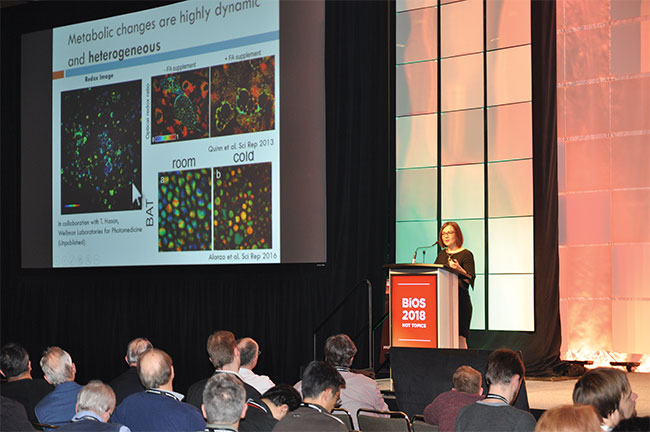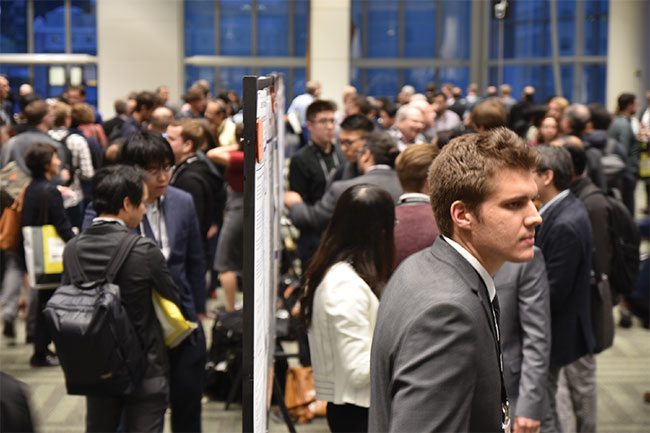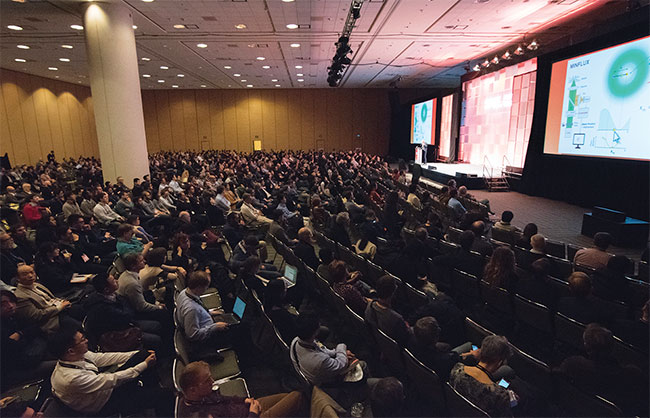SPIE’s BiOS conference and exhibition is renowned worldwide as one of the most important events in the biophotonics industry. It brings together researchers, professors, students, companies, and other industry experts for a weekend of biomedical optics, diagnostics, imaging modalities, neurophotonics, and more.
To be held at the Moscone Center in San Francisco, Feb. 2-3, BiOS 2019 — a part of SPIE Photonics West — will feature symposium chairs James G. Fujimoto of MIT and Dr. R. Rox Anderson of the Wellman Center for Photomedicine at Massachusetts General Hospital, Harvard Medical School, as well as co-chairs Jennifer Barton of the University of Arizona, and Wolfgang Drexler of the Medical University of Vienna.

Plenary and other presentations and talks allow industry experts to share their knowledge and insight with the worldwide biophotonics community. Courtesy of SPIE.
On Sunday, Feb. 3, a special presentation will feature Donna Strickland, professor of physics and astronomy at the University of Waterloo in Canada. She was recently awarded a 2018 Nobel Prize in physics, becoming the third woman ever to receive the honor. Those who came before her were Marie Curie in 1903 and Maria Goeppert-Mayer in 1963.
Strickland’s work that earned the Nobel (performed alongside former Ph.D. supervisor Gérard Mourou) has revolutionized laser physics via the development of a method for “generating high-intensity, ultrashort optical pulses.”
Application tracks
The BiOS conference is separated
into six tracks.
• Photonic Therapeutics and Diagnostics — This sector will feature sessions such as photonics in dermatology and plastic surgery, endoscopic microscopy, optical methods for tumor treatment and detection, and photodynamic therapy. It is co-chaired by Brian Jet-Fei Wong of the Beckman Laser Institute and Medical Clinic at the University of California, Irvine, and Eva Sevick-Muraca of the University of Texas Health Science Center.
• Neurophotonics, Neurosurgery, and Optogenetics — Led by chairs David Boas of Massachusetts General Hospital, Harvard Medical School and Elizabeth Hillman of Columbia University, sessions will include clinical and translational neurophotonics, neural imaging and sensing, optogenetics, and optical manipulation.
• Clinical Technologies and Systems — Tuan Vo Dinh of the Fitzpatrick Institute for Photonics at Duke University and Anita Mahadevan-Jansen of Vanderbilt University will chair this group. It will feature topics such as OCT, coherence domain optical methods in biomedicine, multimodal biomedical imaging, optical tomography, and spectroscopy.
• Tissue Optics, Laser-Tissue Interaction, and Tissue Engineering — This sector, led by E. Duco Jansen of Vanderbilt University and Jessica C. Ramella-Roman of Florida International University, will include optical interactions with tissue and cells, photons and ultrasound for imaging and sensing, optical elastography, and tissue biomechanics, among other topics.
• Biomedical Spectroscopy, Microscopy, and Imaging — Chaired by Ammasi Periasamy of the University of Virginia and Daniel L. Farkas of the University of Southern California and Spectral Molecular Imaging, sessions in this group will include imaging and analysis of biomolecules, cells, and tissues; multiphoton microscopy; single molecule spectroscopy; superresolution imaging; and adaptive optics.
• Nano/Biophotonics — Nanoscale imaging, sensing, and actuation; colloidal nanoparticles for biomedical applications; plasmonics; and nanosensors are among the topics to be featured in this group. Paras Prasad of SUNY Buffalo and Dan V. Nicolau of McGill University will serve as co-chairs.
Hot Topics
The Hot Topics program allows industry experts and researchers to share major breakthroughs in all fields of biophotonics and health care, discussing technology advancements and findings specifically in areas such as photodynamic therapy, optical metabolic imaging, OCT for oral imaging applications, 3D multiphoton optogenetic technology for neural ensemble activity, and GASMA spectroscopy, among others.

Poster sessions will showcase research and technologies during the BiOS conference. Courtesy of SPIE.
Speakers at BiOS Hot Topics, hailing from all over the world, will discuss a variety of bio-related topics. Among the speakers: Samuel Achilefu of Washington University School of Medicine (Power of Light to See and Treat Cancer), Clare Elwell of University College London (New Frontiers in Near-IR Spectroscopy), Alexander Vahrmeijer of Leiden University Medical Center (Precision Surgery by Targeted Molecular Imaging), and Zhiwei Huang of the National University of Singapore (Spectroscopic Cancer Detection).

SPIE BiOS is renowned as one of the most important biomedical optics conferences in the world, bringing together industry and academia. Courtesy of SPIE.
Plenary sessions will also be held during the Hot Topics program, with presentations by Denise Cai of the Icahn School of Medicine at Mount Sinai, Emily Gibson of the University of Colorado Denver, Xavier Intes of Rensselaer Polytechnic Institute, Vivek Srinivasan and Lin Tian, both from the University of California, Davis, and Raju Tomer of Columbia University.
Awards and honors
SPIE recognizes some of the best and brightest in the industry with awards and honors. This includes the Britton Chance Biomedical Optics Award, which is presented annually in recognition of outstanding lifetime contributions to the field of biomedical optics through the development of innovative, high-impact technologies. The award particularly honors pioneering contributions to optical methods and devices that have facilitated advancements in biology or medicine. This year, the honor goes to Samuel Achilefu, professor of radiology, biomedical engineering, and biochemistry and molecular biophysics at Washington University in St. Louis School of Medicine. He is also the director of the school’s optical radiology laboratory, serves as the Michel M. Ter-Pogossian endowed chair in radiology, and is vice chairman of innovation and entrepreneurship at the Mallinckrodt Institute of Radiology.
The 2019 Biophotonics Technology Innovator Award — presented annually for extraordinary achievements in biophotonics technology development that show strong promise or potential impact in biology, medicine, and biomedical optics — will be bestowed upon Stephen Boppart, professor of electrical and computer engineering at the University of Illinois at Urbana-Champagne, where his research focuses on biomedical imaging, bioengineering, and acoustics. This award recognizes Boppart’s development of novel technology in computational OCT and its applications to basic and clinical sciences.
The work of students and young researchers is also recognized with several awards at BiOS. Those being honored will be announced during the conference.
Diseases in the Breast and Reproductive System is the focus of the 2019 Pascal Rol Best Paper Award, judged based on the most “outstanding extended abstracts” on this specific topic.
The 2019 Seno Medical Instruments Best Paper Award recognizes those working in Photons Plus Ultrasound: Imaging and Sensing, while the Journal of Biomedical Optics and Neurophotonics offers a Student Poster Session Competition — where students can present a three-minute, rapid-fire overview of their poster research — based on content and presentation effectiveness. Young Investigator awards are given out as well, recognizing innovative work and research by students and young scientists.
BiOS Expo
The BiOS Expo — the world’s largest biomedical optics and biophotonics exhibition to be held Saturday and Sunday, Feb. 2 and 3 — will host more than 200 companies showcasing their latest technologies, systems, and components for biomedical optics, lasers, molecular imaging, therapeutic lasers, nano/biophotonics, biosensors, and spectroscopic/microscopic imaging.
Among the BiOS exhibitors are Optimax, Andor Technology Ltd., Cobolt AB, Coherent Inc., Ibsen Photonics A/S, Jenoptik, Fresnel Technologies Inc., Ocean Optics Inc., Thorlabs Inc., Xenics NV, and Edmund Optics Inc. For the full list of exhibitors, visit www.spie.org/exhibitor/search.aspx?expo=SPIE-BiOS-2019.
And on Sunday, Feb. 3, at 3 p.m., stop by the Photonics Media booth 8444 to talk with me, Justine Murphy, about trends in the industry, what you’re passionate about, or becoming a contributor for BioPhotonics magazine.